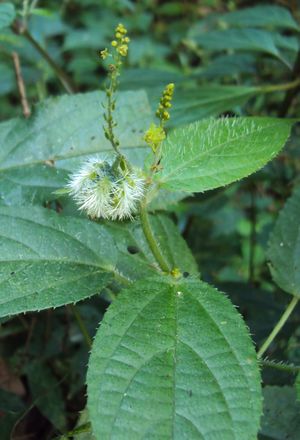Note: This is a project under development. The articles on this wiki are just being initiated and broadly incomplete. You can Help creating new pages.
Tragia involucrata - Duhsparsha
Duhsparsha is a perennial twinning herb, covered with stinging hairs. Alternately arranged leaves are oblong-lanceolate or ovate, toothed, base heart-shaped or rounded, tip long pointed. Flowers are borne in racemes in leaf axils. Female flowers are few, in lower part of inflorescence; male flowers are many in the upper part. Fruit is a 3-lobed capsule, containing 3 round smooth seeds.
Uses
Wounds, Cuts, Snakebites, Curing liver disorders, Skin eruptions, Blotches, Pimples, Diarrhea, Sore throats[1]
Parts Used
Chemical Composition
Seeds yield a fixed oil containing about 62% linoleic acid and enzymes. They are also rich in proteins (Ghani, 2003)[2]
Common names
| Language | Common name |
|---|---|
| Kannada | Turike Balli |
| Hindi | Barhanta |
| Malayalam | Kodithoova, Cherukodithuva |
| Tamil | Kanchori |
| Telugu | Telukondicettu |
| Marathi | NA |
| Gujarathi | NA |
| Punjabi | NA |
| Kashmiri | NA |
| Sanskrit | Vrischikali |
| English | stinging nettle |
Habit
Identification
Leaf
| Kind | Shape | Feature |
|---|---|---|
| Simple | Leaves 6-10 x 3-5.5 cm | Ovate or elliptic, base acute or rounded, margin serrate, apex acuminate, hispidulous on both sides and petiole to 2.5 cm long |
Flower
| Type | Size | Color and composition | Stamen | More information |
|---|---|---|---|---|
| Unisexual | 2 cm long | Yellow | 3-5 | Female flowers c. 3 mm across, ebracteate; tepals 6, c. 1 mm long, ovate-lanceolate, enlarged and spreading in fruits |
Fruit
| Type | Size | Mass | Appearance | Seeds | More information |
|---|---|---|---|---|---|
| enlarged | ovate-lanceolate | Capsule c. 0.6 x 1 cm, 3-lobed, hispid | With hooked hairs | Seeds globose | {{{6}}} |
Other features
List of Ayurvedic medicine in which the herb is used
- Vishatinduka Taila as root juice extract
Where to get the saplings
Mode of Propagation
How to plant/cultivate
Easily grown in most soils[21][22], preferring a calcareous soil. Thrives in a dry lightly shaded position[16], though it prefers full sun. Plants usually self-sow quite freely when growing in a suitable position[19]. The seeds are contained in burrs that can easily attach themselves to clothing or animal's fur, thus transporting them to a new area where they can germinate and grow.The cultivar 'Sweet scented' is popular in France for making tea because the whole plant is sweet scented and the flowers have a spicy apricot-like fragrance[4]
Commonly seen growing in areas
Photo Gallery
References
- ↑ Cite error: Invalid
<ref>tag; no text was provided for refs namedUses - ↑ "chemical plants"
- ↑ "india boidovesrity"
- ↑ "practical palnts"
External Links
- Pages with reference errors
- Pages that are stubs
- Ayurvedic Herbs known to be helpful to treat Wounds
- Ayurvedic Herbs known to be helpful to treat Cuts
- Ayurvedic Herbs known to be helpful to treat Snakebites
- Ayurvedic Herbs known to be helpful to treat Curing liver disorders
- Ayurvedic Herbs known to be helpful to treat Skin eruptions
- Ayurvedic Herbs known to be helpful to treat Blotches
- Ayurvedic Herbs known to be helpful to treat Pimples
- Ayurvedic Herbs known to be helpful to treat Diarrhea
- Ayurvedic Herbs known to be helpful to treat Sore throats
- Herbs with Dried Folaige used in medicine
- Herbs with Whole herb used in medicine
- Herbs with common name in Kannada
- Herbs with common name in Hindi
- Herbs with common name in Malayalam
- Herbs with common name in Tamil
- Herbs with common name in Telugu
- Herbs with common name in Sanskrit
- Herbs with common name in English
- Habit - Annual Herb
- Index of Plants which can be propagated by Seeds
- Index of Plants which can be propagated by Cuttings
- Herbs that are commonly seen in the region of Tall grasslands
- Herbs that are commonly seen in the region of meadows
- Herbs that are commonly seen in the region of Borders of forests and fields
- Herbs



